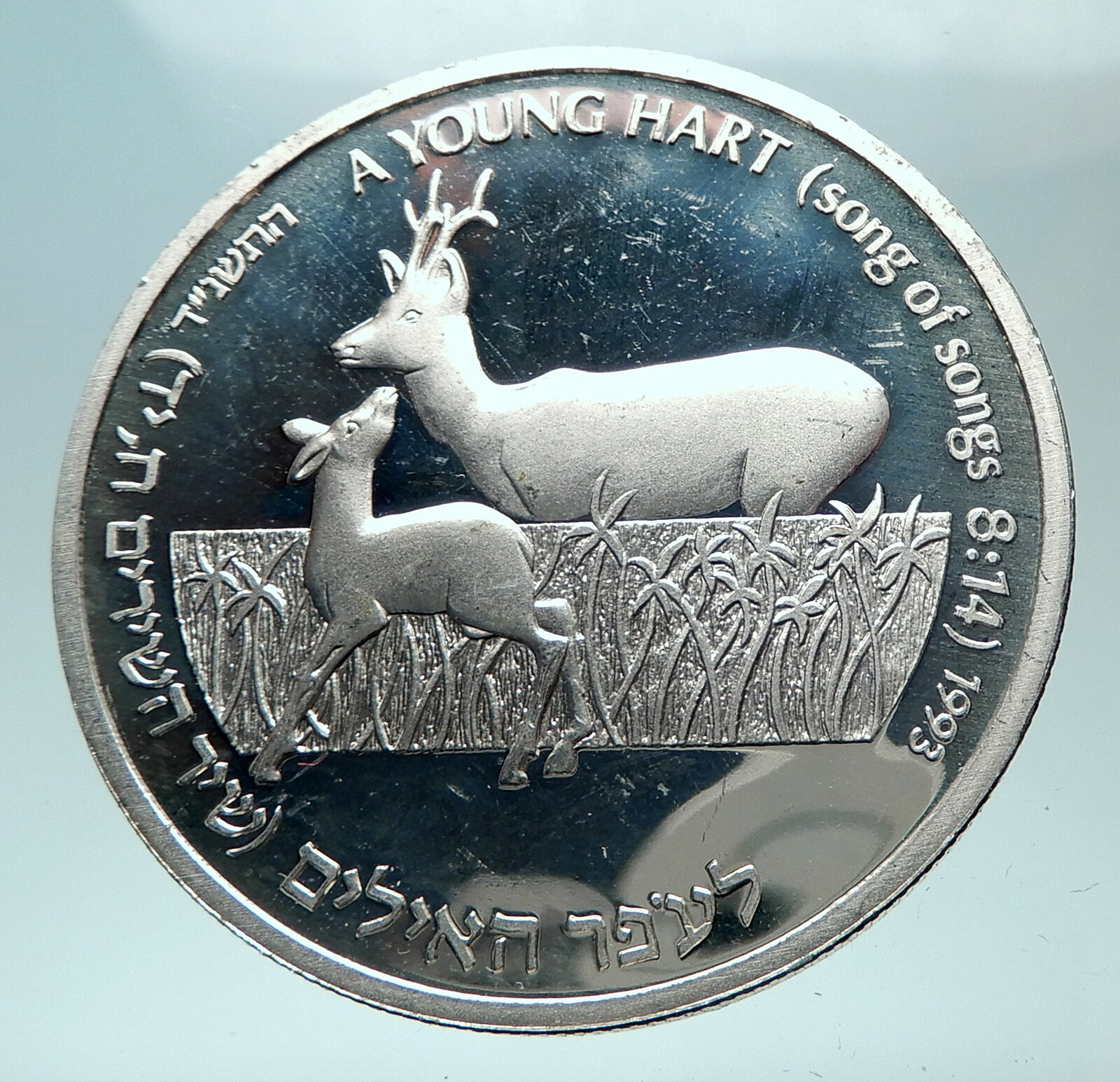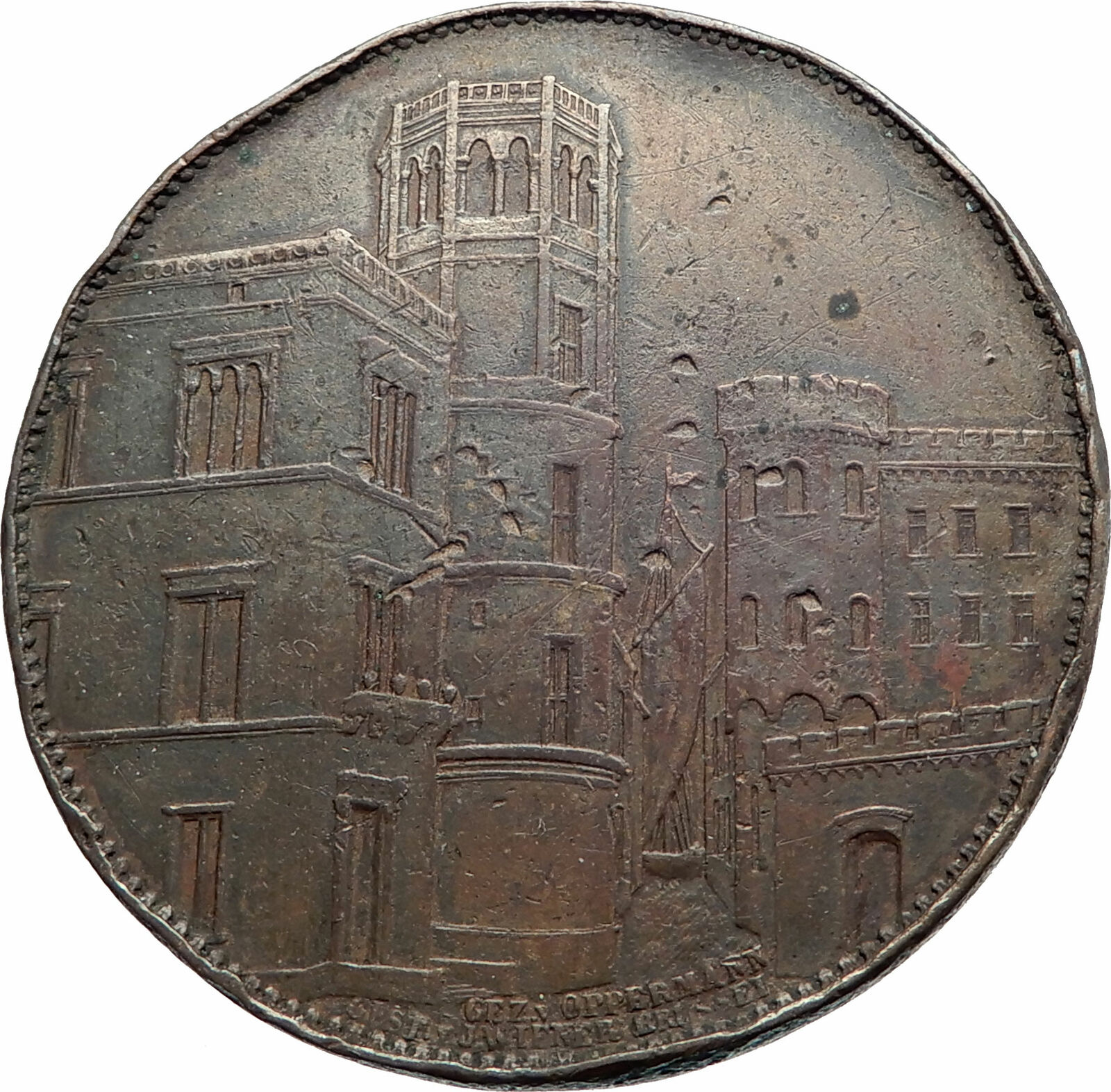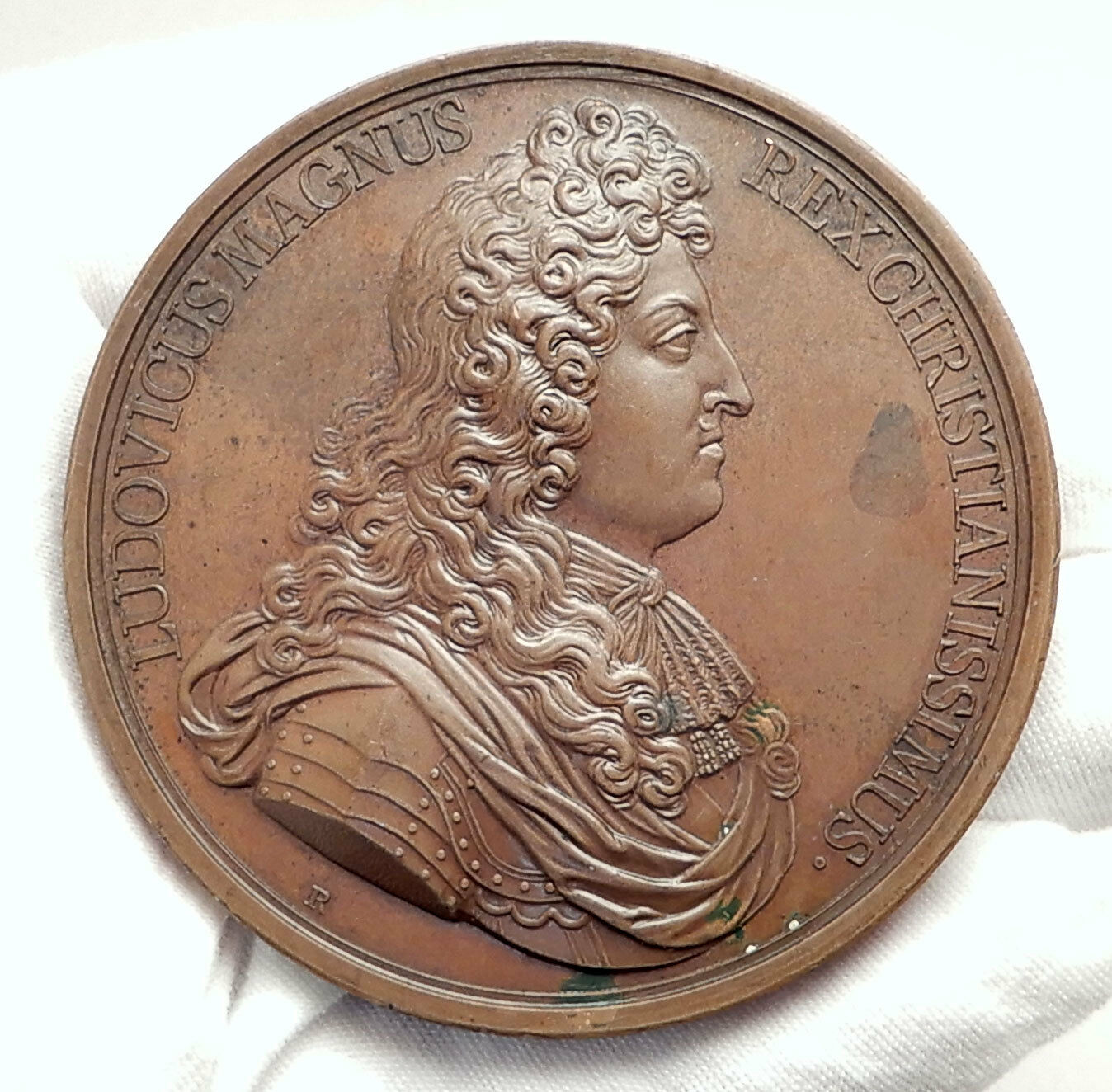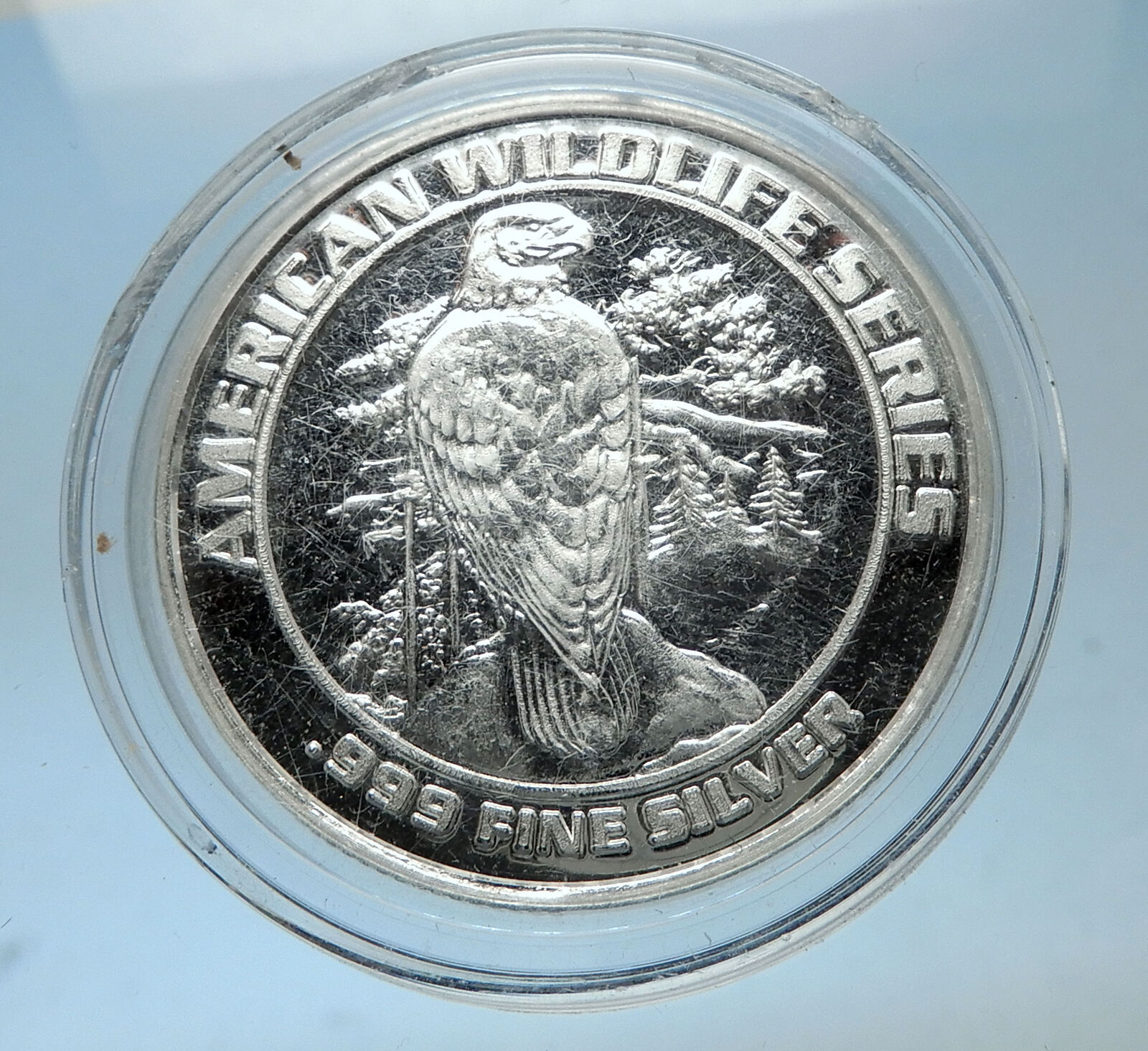|
Austria
Hakoah Sports Club, Vienna – Silver Medal
1921 Silver Medal 26mm (10.54 grams)
SPORT-CLUB “HAKOAH” * WIEN *, Jewish athlete with wreath and shield with Star of David in each hand, wearing matching shirt.
H HAKOAH SPORTKLUB INT. WETTSCHWIMMEN iii 17.u.18.IX 1921, Wreath.
You are bidding on the exact item pictured, provided with a Certificate of Authenticity and Lifetime Guarantee of Authenticity.
 SC Hakoah Vienna (German: Sport Club Hakoah Wien; Hakoah means “the strength” in Hebrew) is a Jewish sports club in Vienna, Austria. SC Hakoah Vienna (German: Sport Club Hakoah Wien; Hakoah means “the strength” in Hebrew) is a Jewish sports club in Vienna, Austria.
Prior to World War II, it produced several Olympic athletes and was notable for fielding an entirely Jewish association football team with players drawn from across Europe. Closed by the Nazis in 1938 following the Anschluss, it re-formed in 1945, though its football team was disbanded in 1949.
A pair of Austrian Zionists, cabaret librettist (Kabarettist) Fritz “Beda” Löhner and dentist Ignaz Herman Körner as well as some others founded the club in 1909. Influenced by Max Nordau’s doctrine of “Muscular Judaism” (German: Muskeljudentum), they named the club “Hakoah” (Hebrew: הכח), meaning “the strength” or “the power” in Hebrew. In its first year, the club’s athletes competed in fencing, football, field hockey, track & field, wrestling and swimming.
Hakoah Vienna was one of the first football teams to market themselves globally by travelling frequently where they would attract thousands of Jewish fans to their matches against local teams in cities such as London and New York. Support for Hakoah spread around Europe rapidly as Jews as far as Russia and the United States avidly supported Hakoah Vienna who took advantage of such support by setting up very successful tours and friendlies. As the first “Jewish” team, Hakoah attracted the attention of prominent Jewish figures including author Franz Kafka. In the offseason, Hakoah traveled around the world marketing their success. However, instead of selling jerseys and other merchandise, Hakoah sold Zionism. In preparation for their visits, they sent promoters ahead of the team in order to generate buzz and attract Jewish fans. Hakoah was not new to the notion of global tours; the organization’s other teams, like swimming and wrestling had already traveled around the world and won a collection of medals. However, the team did often face anti-Semitism during its world travels. The club created an unconventional form of security, having the Hakoah wrestling team accompany them and act as their personal bodyguards.
From 1922 Hakoah leased a sports ground in the Vienna Prater park. The facilities included an athletics track, a sports stadium, football and handball pitches with seating for 25,000 spectators, tennis courts, a jumping pit, hockey field, cloakrooms and showers, a dining area, and groundkeeper’s accommodation. Hakoah finished second in the Austrian League in 1922.
Béla Guttmann played for the team as their centre back from 1922 to 1926 and in 1933. Following a tour of the United States, Guttmann, who was Hakoah’s most prominent player, and several of his teammates decided to stay on in the US.
In the 1920s footballer Max Scheuer played for and captained Hakoah Vienna. With the team he won the Austrian championship in the 1924–25 Austrian First League season, the first professional Austrian football title. In 1927 he and the team came to the United States to play the Bethlehem Steel Football Club, defending U.S. champion and 1926-27 champion of the American Soccer League. During the Holocaust, Scheuer was sent to Auschwitz concentration camp in Poland, where he was killed in the early 1940s. Scheuer was one of at least seven Hakoah footballers killed in the Holocaust. Others were Josef Kolisch, Ali Schönfeld, Oskar Grasgrün, Ernst Horowitz, and the brothers Erwin Pollak and Oskar Pollak.
On the team’s trip to London in 1923, they defeated West Ham United by a score of 5–1, admittedly against a largely reserve team. Nevertheless, Hakoah became the first continental club to defeat an English team in England.
In a dramatic game of the 1924–25 season, Hakoah’s Hungarian-born goalkeeper Alexander Fabian broke his arm. The rules at the time did not allow substitutions so Fabian put his arm in a sling and switched positions with a forward. Seven minutes later Fabian scored the winning goal, clinching Hakoah’s league championship.
In 1926, the team conducted a highly successful tour of the United States. Their game at New York City’s Polo Grounds attracted 46,000 spectators, a record at the time. Many of the team’s players, impressed by the relative lack of anti-Semitism they found, decided to stay in the United States, accepting offers to play for American clubs. Several of these players formed a club called New York Hakoah which won the National Challenge Cup in 1929.
A few players emigrated to Mandate Palestine and founded Hakoah Tel Aviv football club there. The loss of so many talented players effectively put an end to the Austrian football team’s competitiveness.
The athletic club’s success extended beyond the football pitch. Hakoah had highly successful sections in wrestling, fencing, water polo, athletics and swimming with the club producing several Olympic athletes, especially in women’s swimming. As the top Jewish team, Hakoah attracted the attention of prominent Jews including Franz Kafka. The club had its own orchestra and organised balls and other social events. At its pre-war peak, the club had over 8000 members. Watermarks, a 2004 documentary film, tells the story of the Hakoah women’s swim team with historical footage from the 1930s and contemporary interviews with surviving team members.
President of the club from 1928 to 1938 was David (known as Dezsö) Herbst, who was the husband of Austria’s tennis champion Liesl Herbst. He wrote in the celebratory Festschrift (brochure) on the 25th anniversary of the club in 1934:
“In the days of our forefathers, we Jews have completely forgotten the old and true words in the education of our children: Mens sana in corpore sano! We only thought that the new generation should be educated, we neglected what today the whole world recognises as the only proper educational principle: to make our bodies strong.”
By the 1930s Hakoah Vienna was on the receiving end of hatred stirred up by Hitler, and had to travel to matches with their wrestlers as bodyguards. Three days after the Anschluss, the shared club base of Hakoah Sports Club, Hakoah Tourism and Ski Club and the Hakoah Swimming Club at the Viennese Cafe Atlashof, was shut down, with the club assets and stadium seized. The official dissolution of the sports club was administered in the political department IV Ac by the Liquidation Commissioner of the Nazi party. Dezsö Herbst did most of the official work with the Liquidation Commissioner. On 31 March 1938 the liquidator ordered the club to declare and transfer its assets. After the transfer, the final phase of the ‘development’ of Hakoah began. On 16 November 1938, the Liquidation Commissioner sent an application to the Board of the Vienna Police Directorate for a raid on Hakoah Sports Club.
After the Anschluss of 1938, the German Football Association banned the club and nullified their games. Their stadium was appropriated and given to the Nazi party.
In 1945 the club was founded again and exists today. The football team, which played in the second division of the Austrian championship after World War II, became defunct in 1949.
In 2000, the Jewish community of Vienna purchased the club’s old fields within Prater park for €10 million with the intention of building a new community center. As of 2006, the club had about 400 members and its football team plays in Austria’s minor leagues under the name SC Maccabi Wien. The club opened its new home on 11 March 2008.
  Austria, officially the Republic of Austria (German: Republik Österreich), is a federal republic and a landlocked country of over 8.5 million people in Central Europe. It is bordered by the Czech Republic and Germany to the north, Hungary and Slovakia to the east, Slovenia and Italy to the south, and Switzerland and Liechtenstein to the west. The territory of Austria covers 83,879 square kilometres (32,386 sq mi). Austria’s terrain is highly mountainous, lying within the Alps; only 32% of the country is below 500 metres (1,640 ft), and its highest point is 3,798 metres (12,461 ft). The majority of the population speak local Bavarian dialects of German as their native language, and Austrian German in its standard form is the country’s official language. Other local official languages are Hungarian, Burgenland Croatian, and Slovene. Austria, officially the Republic of Austria (German: Republik Österreich), is a federal republic and a landlocked country of over 8.5 million people in Central Europe. It is bordered by the Czech Republic and Germany to the north, Hungary and Slovakia to the east, Slovenia and Italy to the south, and Switzerland and Liechtenstein to the west. The territory of Austria covers 83,879 square kilometres (32,386 sq mi). Austria’s terrain is highly mountainous, lying within the Alps; only 32% of the country is below 500 metres (1,640 ft), and its highest point is 3,798 metres (12,461 ft). The majority of the population speak local Bavarian dialects of German as their native language, and Austrian German in its standard form is the country’s official language. Other local official languages are Hungarian, Burgenland Croatian, and Slovene.
 The origins of modern-day Austria date back to the time of the Habsburg dynasty when the vast majority of the country was a part of the Holy Roman Empire. From the time of the Reformation, many Northern German princes, resenting the authority of the Emperor, used Protestantism as a flag of rebellion. The Thirty Years War, the influence of the Kingdom of Sweden and Kingdom of France, the rise of the Kingdom of Prussia, and the Napoleonic invasions all weakened the power of the Emperor in the North of Germany, but in the South, and in non-German areas of the Empire, the Emperor and Catholicism maintained control. During the 17th and 18th centuries, Austria was able to retain its position as one of the great powers of Europe and, in response to the coronation of Napoleon as the Emperor of the French, the Austrian Empire was officially proclaimed in 1804. Following Napoleon’s defeat, Prussia emerged as Austria’s chief competitor for rule of a larger Germany. Austria’s defeat by Prussia at the Battle of Königgrätz, during the Austro-Prussian War of 1866 cleared the way for Prussia to assert control over the rest of Germany. In 1867, the empire was reformed into Austria-Hungary. After the defeat of France in the 1870 Franco-Prussian War, Austria was left out of the formation of a new German Empire, although in the following decades its politics, and its foreign policy, increasingly converged with those of the Prussian-led Empire. During the 1914 July Crisis that followed the assassination of Archduke Franz Ferdinand of Austria, Germany guided Austria in issuing the ultimatum to Serbia that led to the declaration of World War I. The origins of modern-day Austria date back to the time of the Habsburg dynasty when the vast majority of the country was a part of the Holy Roman Empire. From the time of the Reformation, many Northern German princes, resenting the authority of the Emperor, used Protestantism as a flag of rebellion. The Thirty Years War, the influence of the Kingdom of Sweden and Kingdom of France, the rise of the Kingdom of Prussia, and the Napoleonic invasions all weakened the power of the Emperor in the North of Germany, but in the South, and in non-German areas of the Empire, the Emperor and Catholicism maintained control. During the 17th and 18th centuries, Austria was able to retain its position as one of the great powers of Europe and, in response to the coronation of Napoleon as the Emperor of the French, the Austrian Empire was officially proclaimed in 1804. Following Napoleon’s defeat, Prussia emerged as Austria’s chief competitor for rule of a larger Germany. Austria’s defeat by Prussia at the Battle of Königgrätz, during the Austro-Prussian War of 1866 cleared the way for Prussia to assert control over the rest of Germany. In 1867, the empire was reformed into Austria-Hungary. After the defeat of France in the 1870 Franco-Prussian War, Austria was left out of the formation of a new German Empire, although in the following decades its politics, and its foreign policy, increasingly converged with those of the Prussian-led Empire. During the 1914 July Crisis that followed the assassination of Archduke Franz Ferdinand of Austria, Germany guided Austria in issuing the ultimatum to Serbia that led to the declaration of World War I.
After the collapse of the Habsburg (Austro-Hungarian) Empire in 1918 at the end of World War I, Austria adopted and used the name the Republic of German-Austria (Deutschösterreich, later Österreich) in an attempt for union with Germany, but was forbidden due to the Treaty of Saint-Germain-en-Laye (1919). The First Austrian Republic was established in 1919. In the 1938 Anschluss, Austria was occupied and annexed by Nazi Germany.[14] This lasted until the end of World War II in 1945, after which Germany was occupied by the Allies and Austria’s former democratic constitution was restored. In 1955, the Austrian State Treaty re-established Austria as a sovereign state, ending the occupation. In the same year, the Austrian Parliament created the Declaration of Neutrality which declared that the Second Austrian Republic would become permanently neutral.
Today, Austria is a parliamentary representative democracy comprising nine federal states. The capital and largest city, with a population exceeding 1.7 million, is Vienna. Austria is one of the richest countries in the world, with a nominal per capita GDP of $52,216 (2014 est.). The country has developed a high standard of living and in 2014 was ranked 21st in the world for its Human Development Index. Austria has been a member of the United Nations since 1955, joined the European Union in 1995, and is a founder of the OECD. Austria also signed the Schengen Agreement in 1995, and adopted the euro in 1999.
|





 SC Hakoah Vienna (German: Sport Club Hakoah Wien; Hakoah means “the strength” in Hebrew) is a Jewish sports club in Vienna, Austria.
SC Hakoah Vienna (German: Sport Club Hakoah Wien; Hakoah means “the strength” in Hebrew) is a Jewish sports club in Vienna, Austria.
 Austria, officially the Republic of Austria (German: Republik Österreich), is a federal republic and a landlocked country of over 8.5 million people in Central Europe. It is bordered by the Czech Republic and Germany to the north, Hungary and Slovakia to the east, Slovenia and Italy to the south, and Switzerland and Liechtenstein to the west. The territory of Austria covers 83,879 square kilometres (32,386 sq mi). Austria’s terrain is highly mountainous, lying within the Alps; only 32% of the country is below 500 metres (1,640 ft), and its highest point is 3,798 metres (12,461 ft). The majority of the population speak local Bavarian dialects of German as their native language, and Austrian German in its standard form is the country’s official language. Other local official languages are Hungarian, Burgenland Croatian, and Slovene.
Austria, officially the Republic of Austria (German: Republik Österreich), is a federal republic and a landlocked country of over 8.5 million people in Central Europe. It is bordered by the Czech Republic and Germany to the north, Hungary and Slovakia to the east, Slovenia and Italy to the south, and Switzerland and Liechtenstein to the west. The territory of Austria covers 83,879 square kilometres (32,386 sq mi). Austria’s terrain is highly mountainous, lying within the Alps; only 32% of the country is below 500 metres (1,640 ft), and its highest point is 3,798 metres (12,461 ft). The majority of the population speak local Bavarian dialects of German as their native language, and Austrian German in its standard form is the country’s official language. Other local official languages are Hungarian, Burgenland Croatian, and Slovene. The origins of modern-day Austria date back to the time of the Habsburg dynasty when the vast majority of the country was a part of the Holy Roman Empire. From the time of the Reformation, many Northern German princes, resenting the authority of the Emperor, used Protestantism as a flag of rebellion. The Thirty Years War, the influence of the Kingdom of Sweden and Kingdom of France, the rise of the Kingdom of Prussia, and the Napoleonic invasions all weakened the power of the Emperor in the North of Germany, but in the South, and in non-German areas of the Empire, the Emperor and Catholicism maintained control. During the 17th and 18th centuries, Austria was able to retain its position as one of the great powers of Europe and, in response to the coronation of Napoleon as the Emperor of the French, the Austrian Empire was officially proclaimed in 1804. Following Napoleon’s defeat, Prussia emerged as Austria’s chief competitor for rule of a larger Germany. Austria’s defeat by Prussia at the Battle of Königgrätz, during the Austro-Prussian War of 1866 cleared the way for Prussia to assert control over the rest of Germany. In 1867, the empire was reformed into Austria-Hungary. After the defeat of France in the 1870 Franco-Prussian War, Austria was left out of the formation of a new German Empire, although in the following decades its politics, and its foreign policy, increasingly converged with those of the Prussian-led Empire. During the 1914 July Crisis that followed the assassination of Archduke Franz Ferdinand of Austria, Germany guided Austria in issuing the ultimatum to Serbia that led to the declaration of World War I.
The origins of modern-day Austria date back to the time of the Habsburg dynasty when the vast majority of the country was a part of the Holy Roman Empire. From the time of the Reformation, many Northern German princes, resenting the authority of the Emperor, used Protestantism as a flag of rebellion. The Thirty Years War, the influence of the Kingdom of Sweden and Kingdom of France, the rise of the Kingdom of Prussia, and the Napoleonic invasions all weakened the power of the Emperor in the North of Germany, but in the South, and in non-German areas of the Empire, the Emperor and Catholicism maintained control. During the 17th and 18th centuries, Austria was able to retain its position as one of the great powers of Europe and, in response to the coronation of Napoleon as the Emperor of the French, the Austrian Empire was officially proclaimed in 1804. Following Napoleon’s defeat, Prussia emerged as Austria’s chief competitor for rule of a larger Germany. Austria’s defeat by Prussia at the Battle of Königgrätz, during the Austro-Prussian War of 1866 cleared the way for Prussia to assert control over the rest of Germany. In 1867, the empire was reformed into Austria-Hungary. After the defeat of France in the 1870 Franco-Prussian War, Austria was left out of the formation of a new German Empire, although in the following decades its politics, and its foreign policy, increasingly converged with those of the Prussian-led Empire. During the 1914 July Crisis that followed the assassination of Archduke Franz Ferdinand of Austria, Germany guided Austria in issuing the ultimatum to Serbia that led to the declaration of World War I.




